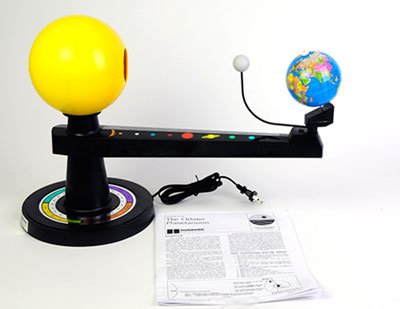Illuminated Orbiter - Sun-Moon-Earth

Price:


Product Feature
- Orbiter with sun, earth and moon models manually revolving around one another
- Powered by a standard wall outlet (power cord is approximately 6' long)
- Product dimensions: 25.5" X 16" X 10.50"
- Includes 8-page lesson plan with investigations and activities
- Excellent for a science fair project for for use in science lessons
Product Description
Light up the Sun with this version of an orbiter. This model can be plugged into a standard wall outlet to illuminate the sun to effectively demonstrate daylight, night, seasons, and phases of the moon. The sun, earth and moon manually revolve around one another on the gear-driven model. The earth and moon are shown in true scale. The scale is 1 inch = 2000 miles. If the sun were to be shown at the same scale, it would be approximately 36 feet in diameter! The arm is 15", the sun is 6" in diameter, and the earth is 4" in diameter. The 8-page lesson plan includes basic investigations and activities on day and night, seasons, the moon, and other observations and activities. Highly recommended for use in the science classroom!Illuminated Orbiter - Sun-Moon-Earth Review
I'm writing a book and needed this Sun, Moon and Earth orbiter model to conceptualize the variable dynamics between these three heavenly bodies, how they interact, and the questions I need to research answers to.The model is somewhat coarse (with some rough edges) but for the price to value ratio, it is above average. The rotations are smooth and for the most part non-jerky (except when you rotate the Moon by itself with your finger, there's a slight click). If you are impatient or have kids that don't appreciate the word "gently!" then this is a fleeting extravagance for the money. If you treat it right, it is an invaluable CONCEPTUAL (not literal) tool. In reality, if it were scale, two aspects would change:
1. The Earth and Moon, if remaining the size of this model, would be 10 feet apart, not a few inches.
2. The Sun would be 36 feet in diameter, at a distance of approx. 1.5 miles from the 4 inch Earth.
In a dimly lit or dark room, this illuminated model (not the non-illuminated model) shows the shadow of the lunar eclipse nicely on the globe. The daylight side of the globe is sharp. While rotating the arm with your hand (gently while holding the base!) these shadows move, allowing conceptualization of the orbital rotation of these bodies. The Moon simultaneously and smoothly rotates around the Earth as you rotate the arm with the Earth and Moon around the Sun. The arrow on the arm points to the month of year of planetary alignment.
The only mystery yet to solve is whether certain continents should be initially aligned with the Moon at a given month alignment, to allow one to see the alignment when rotating to a different month? I kind of doubt it has this level of granularity due to the relative size of Earth and Sun (vs. the real scale). That would be asking a lot of a model that is intended to make you conceptualize orbital and rotational dynamics.
Example: I realized in using this model there is no proverbial "dark side" to the Moon. This metaphor in books and movies is misleading. There is a far side to the Moon, but as the lunar body orbits Earth, its far side is in varying degrees of daylight. When you see a crescent Moon "sliver," the rest of the light in that sliver is illuminating the far side of the Moon. Of course I knew this, but never thought of it so matter-of-factly. I will never refer to the dark side of the Moon, since any given "side" is dark and light at some point in the Moon's orbit.
Most of the consumer Reviews tell that the "Illuminated Orbiter - Sun-Moon-Earth" are high quality item. You can read each testimony from consumers to find out cons and pros from Illuminated Orbiter - Sun-Moon-Earth ...

No comments:
Post a Comment